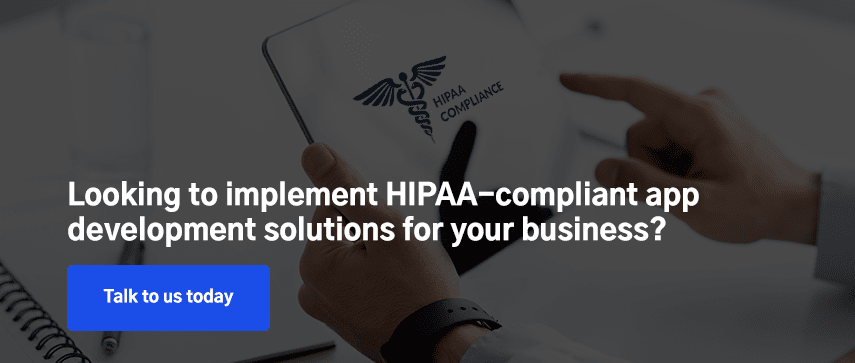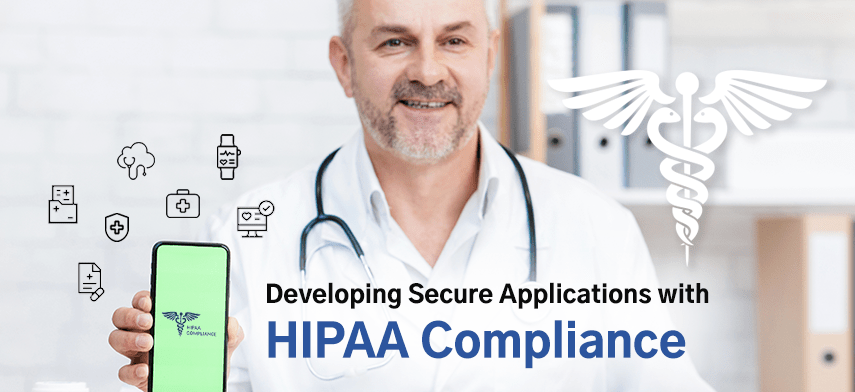Data privacy will continue to be a serious concern. If you are a healthcare app development company or start-up, it is essential to follow the HIPAA compliant app development process. The Health Insurance Portability & Accountability Act is a protection layer for sensitive information & data centers in the health sector.
According to research, data breaches have increased at a capacity of 140% from 2020- 2021. Health and health systems have been immensely impacted by the high rise in data breaches, especially with the rapid implementation of virtual and digital services. Entrusting healthcare apps with HIPAA compliant app development solutions enables the confidentiality of patient data and blocks unauthorized, fraudulent activities. Additionally, HIPAA compliance software protects the privacy of all sensitive information and gives rights to the user to control the incident of violation at any given time.
Entrusting HIPAA Compliant Software in Building Telehealth Applications
Technology is not only changing lives but also the healthcare industry. We are dependent on the mobile app for Medicare or healthcare-related services. HIPAA compliant telehealth platforms are making a remarkable impact on the healthcare industry as these apps are frequently updated ensuring maximum measures taken for safety.
HIPAA compliant software is advanced and patient-centric as artificial intelligence and machine learning play an impactful part. These HIPAA compliant mobile apps are complete value-based solutions and can contribute to building a secure telehealth application. Since the onset of the pandemic, telehealth has become an essential part of protecting our health and well-being. Hence, it is important to select a platform that suits the needs and requirements of a facility or organization.
Telehealth clinical services have shot up in the last 1.5 years as patients and providers alike are finding it easy to connect and communicate their concerns. But considering the current state of affairs, there are several HIPAA Privacy Rules Covered Entities under Protect Health Information (PHI).
HIPAA Privacy Rules Covered Entities under PHI
Privacy rules aren’t inclusive of all persons or institutions that collect health information. HIPAA privacy rules apply only to covered entities. The covered entities as per HIPAA rules are:
- Health Plan
- Healthcare clearinghouses
- Health care providers
- Business Associate
All entities that transmit any health information, including billing and payment details, come under the HIPAA privacy rule. Institutions, organizations, or persons can also be under-covered entities. But before building a stable, effective, and covering all essential areas of data security, HIPAA compliant telehealth apps are required to follow a few constructional steps.
Steps to Construct HIPAA Compliant Telehealth Apps
To build a HIPAA compliant telehealth app, there are a few steps to follow:
- Protect the patient health information of health plans, health care, and health clearinghouse entities.
- Limit the use of PHI to accomplish the intended task.
- Select the business associates who have the covered functions.
- Follow procedures to limit the access of PHI and train the staff to protect the patient information.
To make any healthcare or medical app HIPAA compliant, we need to check the following requirements:
1 Encryptions
It is a must for any telehealth software or health app to keep the patient data encrypted during the transmission of PHI. To achieve this, app development companies should use HTTP protocols and SSL.
2 Generate backup
The telehealth clinical services app development company must provide recovery and backup services in any accidental data loss.
3 Secure authorization
App development companies are required to build and upgrade the app with protected authorization. To do so, audit of access control needs to be a regular practice. For example, check the authenticity of the person who is using the data. Keep track of logins, and ensure optimum security.
4 Integrity
While planning to develop a telehealth HIPAA compliant app, it must pay attention to the infrastructure. The infrastructure should ensure the safe storage, transfer, and collection of data. It should prevent unauthorized access and should be able to detect similar issues. Additionally, the app should take measures like backup, access authorization, and encryption-based protocols.
5 Encrypted storage
The app is required to follow the PHI rule, and the entire software system, like database, logs, and backups, should cover this data rule. Furthermore, data breaches and phishing should be prevented with encrypted data transfer.
6 Disposal of the data
According to HIPAA compliance in telemedicine platforms, the safe disposal of backed-up and archived data is a must for any telehealth app. Therefore, the app should use the non-retrievable method of data disposal.
Developing a HIPAA Compliant app
The process of developing a HIPAA compliant app is very different from other app development processes. Digital maturity is expected in entities like the healthcare and medical industries.
As we know, HIPAA ensures safe data handling and storage as per rule, which includes information sharing, billing, and other patient details. Therefore, to develop a HIPAA compliant APP, you need more precision and regulations than any other app development.
Let’s understand the process of developing a HIPAA compliant application.
1 Create a user identification
As per HIPAA, email user login is not the safest way. Therefore, it is mandatory to create user authentication with a secured PIN or password. Using biometrics or smart cards will be an additional advantage. Therefore, before the development of the app, one should keep this aspect in mind.
2 Emergency Access
Data access is required to be continued in all conditions during any emergency. For example, in situations like power failure or natural disasters, the app should provide emergency access. This is not a direct requirement from HIPAA but can be an essential feature in any healthcare app development process.
3 Encryption in data transit
Always prefer the services like AWS or Google cloud for data transmission as these service providers use the transport layer 1.2. Plus, these cloud vendors provide complete encryption in data transmission and ensure technical safeguard. During the app development installation, these protocols safeguard all the specifications for identification, encryption, or authentication. Introducing end-to-end encryption with TLS, which is essential for inbound or outbound packets of information or data is mandatory. Then, fortify this with the AES encryption process.
HIPAA Health Application Use Cases and Recognizing Unconfirmed HIPAA Applications
Imagine a use case where a consumer downloads a health app on his smartphone that is developed to manage their chronic conditions. Downloading the data from the doctor's EHR via a patient portal on his computer, and then upload it in the app adding their personal information. In such a scenario, the app is not creating, maintaining, or transmitting PHI on behalf of any business associate or covered entity. Instead of that, the customer obtains the health information from his service provider and uses the app to manage the data and organize it. This kind of facilitation is HIPAA compliant as there is no indication of business associates who used or breached the data.
It is essential to consider whether an app is HIPAA compliant or not. Thus, it is important to store or transmit the data in a protected environment. For validating whether an app is HIPAA compliant or not, a few things to keep in mind:
1 Check for PHI in the application
If the app stores, collects, manages, or transmits the PHI to covered entities, it should be HIPAA compliant.
2 User communication
HIPAA protects sensitive information about the patient, and it is paramount that it should be designed in a way that subscribers can communicate while using the app. For example, considering emails that are not compliant with HIPAA as they lack content encryption. Hence, the use of email for sharing PHI is a complete violation of HIPAA.
3 Push notification
Mobile phones are insecure devices, and push notification runs the risk of privacy violation as per HIPAA regulations. HIPAA violations are expensive. If any data breach or non-compliance is based on negligence, the fine can rise from USD 100 to more than USD 50,000 per violation. Thus, the penalty can be increased up to USD 1.5 million and the fines are based on the number of patients and level of negligence.

Suggestions to Manage the PHI storage, transmission, and Reception Strategies
Protected health information or personal health information is considerably prone to vulnerability and data phishing. Series of cyberattacks occurred resulting in personal and medical data breaches of patients. To protect HIPAA guidelines, implementation of rules is a mandate for any healthcare or medical app.
A few suggestions to PHI secured during storage, transmission, and reception include:
1 Prioritization
Always be on track to train employees on a frequency basis for auditing the existing system. Make employees aware of the security requirement. Run random phishing tests with the team and make sure they deny and decline any potential threats.
2 PHI access control
Based on requirements, decide the control of access to PHI. Give the role-based access and keep these protocols enforced even if any team member has been promoted or shifted to different departments within the organization. All information should be encrypted to avoid any data breach or theft from any electronic and mobile devices.
3 Regular evaluation of security
It is mandatory to have authorized and impromptu checks with the vendor's certifications for complete privacy and safety even before starting the operations. Additionally, third-party vendors should have a business associate agreement.
4 Validate file-sharing
Get a complete lifecycle of the shared file, including who has access to the file and the time of access or status of the download. Always keep a track of PHIto avoid compromisation at any stage of risk assessment.
Digital Solution Platforms Enhancing Protection of Personal Health Information
Digital solution platforms have a positive impact on personal health information. Blockchain electronic health records, AI-enabled devices, and telemedicine are great examples of digital transformation. This digital transformation in healthcare is reshaping the PHI. Patient data is being processed safely during transmission from one end to another; taking data backup and protecting it from malware or phishing are a few unique digital transformation features observed in the last few years. Technology is lowering the cost, reducing human errors, and improving data management to a massive degree.
HIPAA compliant mobile apps are being used to maintain telehealth services in recent years and have become the best solution during the ongoing pandemic. Furthermore, these advanced solutions are enabled with enhanced encryption to provide end-to-end solutions during transmission. There are no user boundaries; as they can use the files even outside the organization, enabling them to acquire diligent data storage with business associates under HIPAA rules and regulations.
Wrapping up,
Finding the right HIPAA-compliant software for your medical or telehealth services is no longer a challenge. Select a service provider or HIPAA compliant health care app as per the required workflow of your organization. HIPAA compliant software is designed to provide complete patient data information safety during storage, transmission, and usage. HIPAA compliant telehealth apps are creating a safe space for patients, providers, and payors for better accessibility and rapid information roll-outs with diminished hassles. With our digitally integrated healthcare solution, building a HIPAA compliant app development process is simplified. Hence, it assists you to generate better health outcomes while providing an excellent user experience enabling patient satisfaction.





 August 23, 2021
August 23, 2021


